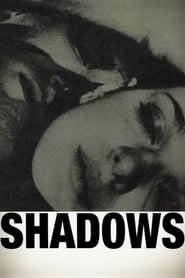
In 1957 John Cassavetes was a very successful character actor who had a passion for acting that pushed him into opening an acting workshop in New York. The workshop actively promoted improvisational acting, being non-scripted and made up at the moment dialogue. Cassavetes took a story outline of three African American siblings whereby only one is dark skinned with their relations to the white world as a premise in taking the best actors from his workshop and filming ,improvised rehearsed and scripted set ups. The film that developed is, “Shadows”, but this first version of the movie was apparently so confusing that Cassavetes discarded it and in 1959 wrote a script using many scenes from the original incorporated within new scripted scenes that would add to the improvised sections, in order to create a linear story. The result is the only version of the film that exists today. The movie looks like a home made amateur movie as it was filmed with a 16mm hand held camera. The improvisational aspect of it also resulted in the camera not being prepared for the actors sudden movements, which in turn produced many jerky changes of directions and sudden unfocused close ups. The grainy black and white film increased the extent of the amateurish feel of the movie. The movie was filmed in an actual New York apartment and outside in the bustling streets of New York. The story centers on one of the three siblings. The light skin colored Lelia, who has a relationship with three men during the short 87 minute running time. The first is an older uptight and jealous white writer. The 2nd a white young and shallow predator and the third a shy sensitive but ultimately conservative black man. The 2nd date does not even realize the Lelia is black (The actress playing her is actually Sicilian). This is a difficult movie to watch at the beginning but while following the procedures, I actually found myself caring about the people and their actions. Part of this is that the unorthodox filming method combined with real and rehearsed improvisational dialogue, served to enhance a feeling of reality that invokes real and stunning emotions. Even when the camera just stares at the characters faces without any dialogue, I got the feeling I was watching real people and not actors. The pulsating jazz score and hip (for the period) language also served to give a real feeling of the young beat movement going on at the time. Watching the raw outdoor scenes of New York with its noise and bright lights instilled a bit of City light wonder, that would be copied in later more celebrated films such as Schlesinger’s . “Midnight Cowboy” and Scorsese’s “Mean streets”. Still the raw emotions, kinetic atmosphere were still not enough to keep me fully involved throughout. Sections of the the film appeared more forced then others and I just could not get over the cheap feel of the 16 mm camera and sometimes unclear audio. Fascinating in parts, the movie is worth a look for its raw energy and real emotions, but not recommended for those looking for a more fulfilling movie experience.

